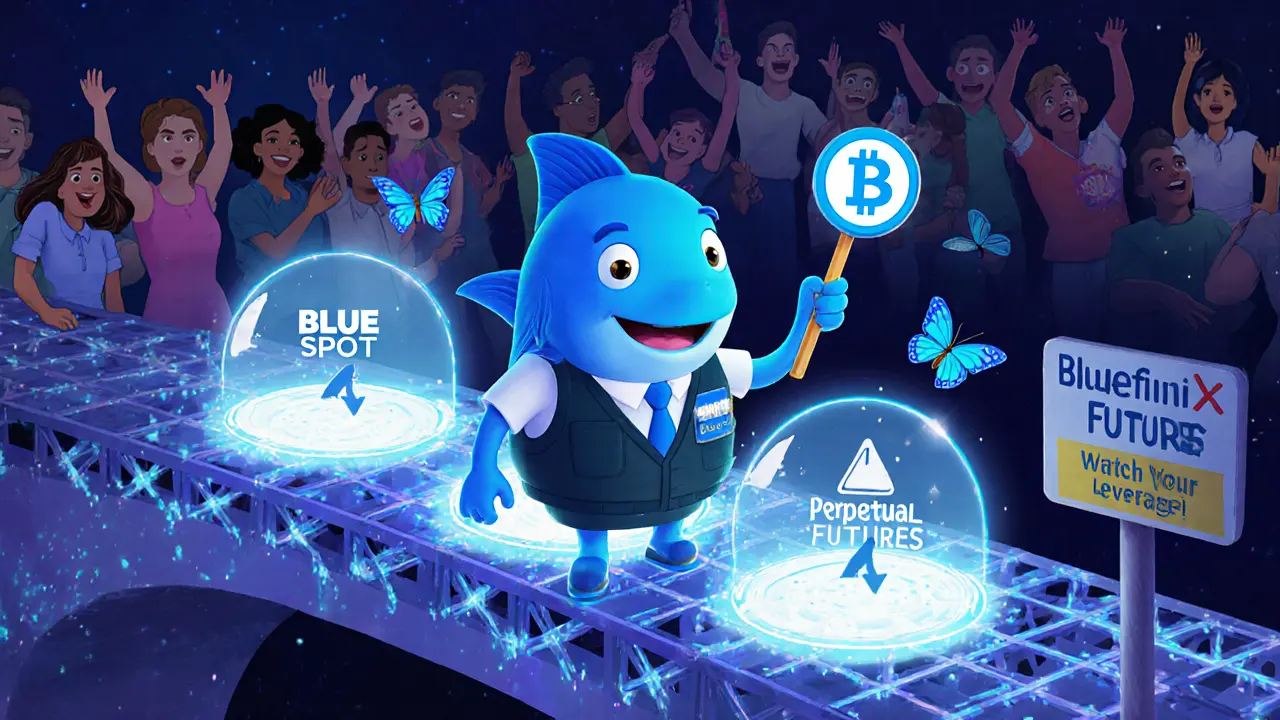Bluefin Leverage Calculator
Leveraged Trading Calculator
Bluefin supports up to 20x leverage for perpetual futures. Liquidations occur when your margin balance falls below the required maintenance margin.
Bluefin (BLUE) isn’t just another crypto coin. It’s the heartbeat of one of the fastest-growing decentralized finance ecosystems on the Sui blockchain. If you’ve heard about Bluefin in passing-maybe you saw it on CoinMarketCap or got an airdrop notification-you might be wondering: what does this token actually do? And why should you care?
What Bluefin (BLUE) actually is
Bluefin is a decentralized exchange (DEX) built entirely on the Sui blockchain. The BLUE token is its native currency, used for governance, rewards, and paying fees. Unlike centralized exchanges like Binance or Coinbase, Bluefin lets you trade directly from your wallet-no sign-ups, no KYC, no middlemen. But it’s not just a simple swap platform. Bluefin offers three core products: Bluefin Pro for perpetual futures trading, Bluefin Spot for buying and selling tokens, and BluefinX, an aggregator that finds the best prices across liquidity pools.
Think of it like a high-speed trading hub designed for people who want fast, cheap trades without sacrificing control. It’s not for everyone-but if you’re active in DeFi, especially on Sui, it’s one of the most important tools you’ll use.
How Bluefin works on the Sui blockchain
Bluefin’s speed and efficiency come from Sui’s unique technology. While Ethereum struggles with slow confirmations and high gas fees, Sui can process up to 30,000 transactions per second with finality in under half a second. That’s the kind of performance usually reserved for centralized exchanges.
Bluefin takes full advantage of this. When you open a leveraged position or swap tokens, your trade executes almost instantly. There’s no waiting for blocks to confirm. This makes Bluefin ideal for high-frequency traders, scalpers, and anyone who hates slippage on volatile assets.
It uses a system called Concentrated Liquidity Market Making (CLMM), which lets liquidity providers focus their funds on specific price ranges. This means tighter spreads and better prices for traders. It’s the same tech Uniswap v3 uses-but on a much faster chain.
BLUE tokenomics: Supply, distribution, and utility
The total supply of BLUE is capped at 1 billion tokens. At launch, about 150 million were in circulation. As of October 2025, the circulating supply is around 310 million, with a market cap hovering near $20 million.
Here’s how the tokens are allocated:
- 19.68% - Airdropped to early users and point holders
- 12.82% - Future incentives for trading and liquidity provision
- 15% - Team and advisors (vested over 2 years)
- 20% - Investors (vested over 1-3 years)
- 32.5% - Foundation and ecosystem reserves
The token isn’t just for speculation. Holding BLUE gives you voting power on protocol upgrades, fee structures, and new features. You can also earn rewards by providing liquidity or staking your tokens once those features go live.
Right now, utility is limited. Most users hold BLUE because they believe in Bluefin’s growth, not because they’re using it for anything beyond governance. But the roadmap includes staking rewards, a decentralized insurance fund, and cross-chain expansion-so that could change.

Why Bluefin dominates the Sui ecosystem
Bluefin isn’t just another DEX on Sui-it’s the biggest by far. As of mid-2024, it handled over $40 billion in trading volume, making up about 72% of all trading activity on the entire Sui blockchain. That’s more than all other DEXs combined.
Why? Because it was the first to deliver professional-grade trading tools on Sui. While other platforms offered basic swaps, Bluefin launched with perpetual futures, leverage up to 20x, and deep liquidity on major pairs like SUI/USDC and ETH/SUI.
Compare that to Uniswap on Ethereum: it supports dozens of blockchains but struggles with speed and cost. Bluefin doesn’t need to be everywhere-it just needs to be the best on Sui. And so far, it has.
Where Bluefin falls short
Bluefin’s biggest weakness is its lack of cross-chain support. Unlike 1inch or Matcha, which pull liquidity from Ethereum, Polygon, Arbitrum, and others, Bluefin only works on Sui. If you don’t own SUI or don’t want to bridge assets over, you can’t use it.
Another issue: user experience isn’t perfect. Beginners often get overwhelmed by the interface. Leverage settings can be confusing-18% of negative Reddit comments mention unexpected liquidations from misconfigured positions. Customer support response times are slow, and there aren’t enough beginner guides.
Also, institutional adoption is minimal. Only three custody providers (Anchorage, Fireblocks, Copper) support BLUE, compared to over a dozen for Ethereum-based tokens. That means big players aren’t yet putting serious money into it.
What users really say about Bluefin
On Reddit’s r/SuiNetwork, 68% of users praised Bluefin for its low slippage and smooth interface. One trader wrote: “I’ve traded on Bybit and dYdX-Bluefin Pro feels faster and cheaper.”
But on Trustpilot, the average rating is 3.8/5. Complaints focus on:
- Complex fee structures for leveraged trades
- Front-end glitches during market spikes
- Lack of educational content for new traders
On CoinMarketCap, users give it 3.9/5, with many noting the mobile app is better than most DEXs. The learning curve is real-you can learn spot trading in 2-3 hours, but mastering perpetuals takes 10-15 hours.

What’s next for Bluefin and BLUE
Bluefin’s roadmap is ambitious. In September 2024, they launched isolated and cross-margin accounts, plus integration with Sui’s zkLogin for easier sign-ups. No more seed phrases or wallet imports-just log in with Google or Apple.
By Q2 2025, they plan to expand to the Aptos blockchain, which could double their potential user base. They’re also building a decentralized insurance fund to protect traders from liquidation cascades-a feature that could make Bluefin the safest DEX for leveraged trading.
If Sui’s Total Value Locked (TVL) keeps growing (it’s at $1.2 billion as of September 2024), Bluefin will likely capture more than half of that activity. That’s the big bet: if Sui succeeds, BLUE does too.
Should you buy BLUE?
It depends.
If you’re already active on Sui-trading, staking, or using DeFi apps-BLUE is essential. It’s the token that powers the ecosystem’s most important platform. Holding it gives you a say in its future.
If you’re new to crypto or prefer Ethereum-based tools, Bluefin isn’t for you yet. The lack of cross-chain support and low institutional backing make it a risky bet outside Sui’s ecosystem.
Price predictions vary wildly. Some models say BLUE could hit $0.14 by end of 2025. Others warn of a drop to $0.0048 in 2026. That volatility isn’t unusual for a token tied to one blockchain’s success.
Bottom line: BLUE isn’t a get-rich-quick coin. It’s a long-term play on Sui’s growth. If you believe Sui will become a top-tier blockchain, then BLUE is one of the clearest ways to bet on it.
How to get started with Bluefin
To use Bluefin, you need:
- A Sui-compatible wallet (Sui Wallet or Martian Wallet)
- SUI tokens to pay for gas
- Some USDC or other stablecoins to trade
Visit bluefin.io, connect your wallet, and you’re ready to trade. No KYC. No account creation. Just start.
Start with spot trading. Get comfortable with the interface. Then try a small leveraged position-5x or less. Watch how liquidations work. Read the tutorials. There are 23 video guides and 127 pages of docs available.
Join the Discord. With over 14,000 members, it’s the best place to ask questions and learn from experienced traders.
Ron Murphy
October 31, 2025 AT 01:34Bluefin’s CLMM implementation on Sui is wild. I’ve seen spreads on SUI/USDC tighten to 0.02% during low volatility-something you’d never see on Uniswap v2. The gas fees are practically invisible, and the UI doesn’t lag even when the market’s going nuts. It’s not perfect, but it’s the closest thing to a centralized exchange that still respects your keys.
Prateek Kumar Mondal
October 31, 2025 AT 20:17Nick Cooney
November 1, 2025 AT 23:10So let me get this straight… you’re telling me a DEX with less than $20M market cap handles 72% of Sui’s trading volume… and the team gets 15% of the token supply… but you’re not worried about centralization? 🤔
Also I just tried to open a 15x position and my wallet crashed. Guess I’ll stick to Bybit.
Clarice Coelho Marlière Arruda
November 3, 2025 AT 03:05i just tried bluefin for the first time and wow the spot trading is smooth but the leverage settings had me sweating like i was in a casino
also why is there no video tutorial for cross-margin? i spent 45 mins figuring it out and now i think i might’ve accidentally liquidated myself
Brian Collett
November 3, 2025 AT 04:41Anyone else notice how BluefinX finds better prices than 1inch on Sui? I swapped 500 USDC for SUI and saved like 1.2% in slippage. That’s not a fluke. The aggregator is quietly brilliant.
Also the Discord is actually helpful. Not like those crypto Twitter bots that just spam memes.
Allison Andrews
November 4, 2025 AT 21:38It’s interesting how Bluefin ties its value to the success of Sui as a whole. It’s not just a token-it’s a vote on whether we believe in a new kind of blockchain infrastructure.
But I wonder if that’s too much dependency. What if Sui hits a wall? What if the next big chain is something we haven’t even heard of yet?
Is Bluefin a bet on technology… or just on timing?
Wayne Overton
November 5, 2025 AT 10:37Alisa Rosner
November 6, 2025 AT 23:11NEW USERS: start with spot trading ONLY! 🚨
Don’t touch leverage until you’ve watched all 23 videos on their YouTube channel. I lost $800 in 2 minutes because I didn’t understand how isolated margin works. 😭
Also use Martian Wallet-it’s way more stable than Sui Wallet right now. And yes, the mobile app is actually good! 👏
MICHELLE SANTOYO
November 7, 2025 AT 21:14Bluefin isn’t a DEX-it’s a cult. Everyone’s obsessed with Sui like it’s the second coming. But what if it’s not? What if we’re all just chasing the next hype train while real infrastructure collapses under Ethereum’s weight?
And don’t even get me started on the ‘community governance’-the foundation holds 32.5% of the supply. That’s not decentralized. That’s a Trojan horse with a nice UI.
Lena Novikova
November 9, 2025 AT 13:01Kevin Johnston
November 11, 2025 AT 04:12Dr. Monica Ellis-Blied
November 12, 2025 AT 20:57While Bluefin demonstrates remarkable technical innovation, we must not overlook the ethical implications of its token distribution model.
With nearly one-third of the supply held by the foundation-and with no transparent governance mechanism for its allocation-we are witnessing a form of protocol-level opacity that contradicts the foundational ethos of decentralization.
Furthermore, the absence of robust educational infrastructure for retail participants raises serious concerns about financial literacy and systemic risk.
This is not merely a trading platform-it is a social contract in code. And contracts require transparency.
Herbert Ruiz
November 14, 2025 AT 13:5972% market share? That’s not dominance. That’s a monopoly. And monopolies in DeFi are dangerous.
Also, you mentioned 14,000 Discord members. Great. But how many of them are bots? How many are paid shills? How many are just holding BLUE because they got an airdrop and don’t know what they’re holding?
Stop romanticizing this. It’s a speculative asset wrapped in tech jargon.